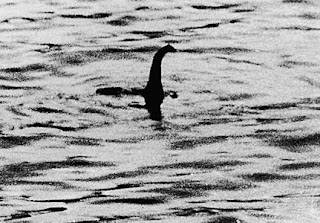
Mysteries of the Unexplained, a section of Reader's Digest magazine, provides an enormous amount of evidence saying that the Loch Ness Monster does exist. It has numerous witness stories from reliable sources, several pictures that seem impossible to be phony, and sufficient scientific data. For example, this picture is said to resemble a large flipper, and was picked up by an underwater camera. The picture coincides with an underwater sonar probe's reading of movement of an unidentified, large object. Father Gregory, monk studying at Loch Ness, and his colleague were startled to see an enormous beast emerge from the water. "In fact, my friend said if I hadn't been with him he'd probably have run, but not from a sense of personal danger; rather from a sense of the inexplicable. It gave us a feeling of something from another world" stated Father Gregory (146).
In this section of Mysteries of the Unexplained, information supports the myth of the Loch Ness Monster. Since I believe the Loch Ness Monster is real, I enjoyed this article and found significant information.
Marshall, Richard, writer. Mysteries of the Unexplained. Pleasantville, N.Y. The Reader's Digest Association, Inc. 1982. Print.
Wednesday, March 31, 2010
Positive Reinforcement to Nessie's Existence
Posted by David Tourtellotte at 6:41 PM 1 comments
Thursday, March 25, 2010
The Loch Ness Monster: Myths and Reality
The Book of Great Mysteries, written by a collection of contributors and edited by Colin Wilson and Dr. Christopher Evans, explores some of the many legends from countries all over the world that continue to fascinate humanity. These mysteries range from the story of King Arthur to the UFO phenomenon. The editors devote a chapter specifically to the mystery of the Loch Ness Monster of Scotland. They begin this story with the first sightings of a monster that lived in the loch, or lake, as we would call it in the United States. The chapter includes the news reports that were local stories at first, but grew into international myths. One of the most complete descriptions of the monster came in July of 1933, from Mr. George Spicer, a visitor from London. His description included a creature that had “a long undulating neck little thicker than an elephant’s trunk, a tiny head, a thick ponderous body, and four feet or flappers”(116). As more people began to claim to have seen the monster, its fame grew worldwide, and people began to travel to Scotland to attempt to see the monster of Loch Ness, or “Nessie”. Investigations were begun to try to solve the mystery, whether to prove or disprove the existence of such a creature.
There are many aspects to the story of the Loch Ness Monster; the legends, attempts to photograph the monster, the skeptics that want to disprove it, and the impact on the people of Scotland. This book provides excellent descriptions of the various accounts of sightings and efforts to find the truth. Press coverage, scientific explorations, amateur investigators are all included in this telling of the Loch Ness story. The Scottish Daily Record published one of the most famous photographs of the monster, and the London Daily Mail published the famous “Surgeon’s Photo” taken by Dr. R.K. Wilson in 1934. The BBC (British Broadcasting Company) sent a television crew with depth-finding equipment to look for the monster in the lake. This book provides a very helpful source in gathering the myths as well as the efforts to prove reality.
amateur investigators are all included in this telling of the Loch Ness story. The Scottish Daily Record published one of the most famous photographs of the monster, and the London Daily Mail published the famous “Surgeon’s Photo” taken by Dr. R.K. Wilson in 1934. The BBC (British Broadcasting Company) sent a television crew with depth-finding equipment to look for the monster in the lake. This book provides a very helpful source in gathering the myths as well as the efforts to prove reality.
Wilson, Colin, and Dr. Christopher Evans, eds. The Book of Great Mysteries. New York: Dorset Press, 1990. Print.
Posted by David Tourtellotte at 8:34 PM 0 comments

